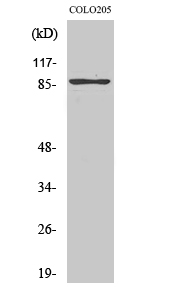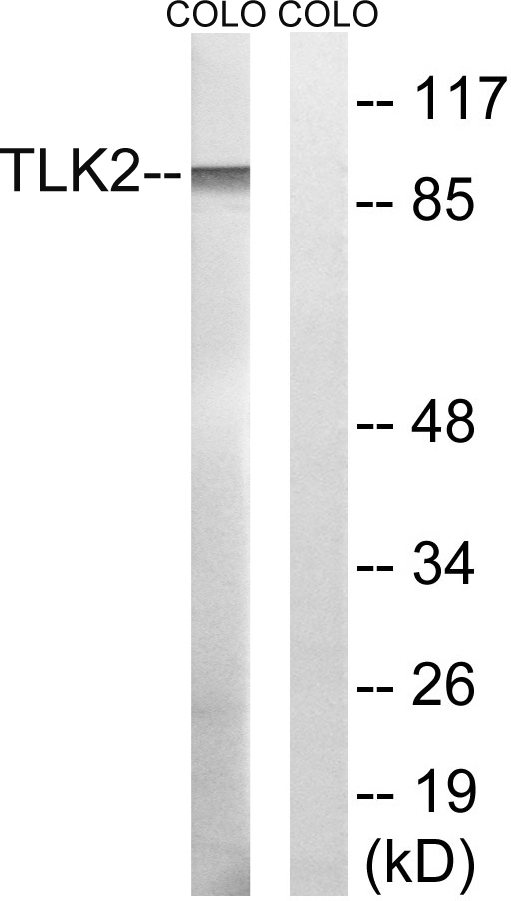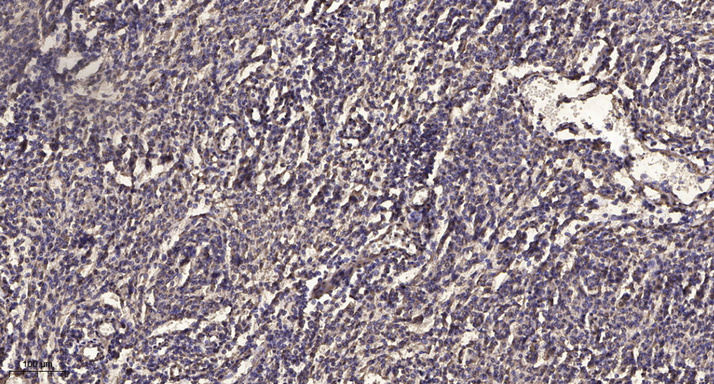TLK2 Polyclonal Antibody
- Catalog No.:YT4674
- Applications:WB;ELISA;IHC
- Reactivity:Human;Mouse
- Target:
- TLK2
- Gene Name:
- TLK2
- Protein Name:
- Serine/threonine-protein kinase tousled-like 2
- Human Gene Id:
- 11011
- Human Swiss Prot No:
- Q86UE8
- Mouse Gene Id:
- 24086
- Mouse Swiss Prot No:
- O55047
- Immunogen:
- The antiserum was produced against synthesized peptide derived from human TLK2. AA range:191-240
- Specificity:
- TLK2 Polyclonal Antibody detects endogenous levels of TLK2 protein.
- Formulation:
- Liquid in PBS containing 50% glycerol, 0.5% BSA and 0.02% sodium azide.
- Source:
- Polyclonal, Rabbit,IgG
- Dilution:
- WB 1:500-2000;IHC 1:50-300; ELISA 2000-20000
- Purification:
- The antibody was affinity-purified from rabbit antiserum by affinity-chromatography using epitope-specific immunogen.
- Concentration:
- 1 mg/ml
- Storage Stability:
- -15°C to -25°C/1 year(Do not lower than -25°C)
- Other Name:
- TLK2;Serine/threonine-protein kinase tousled-like 2;HsHPK;PKU-alpha;Tousled-like kinase 2
- Observed Band(KD):
- 90kD
- Background:
- This gene encodes a nuclear serine/threonine kinase that was first identified in Arabidopsis. The encoded protein is thought to function in the regulation of chromatin assembly in the S phase of the cell cycle by regulating the levels of a histone H3/H4 chaperone. This protein is associated with double-strand break repair of DNA damage caused by radiation. Pseudogenes of this gene are present on chromosomes 10 and 17. Alternate splicing results in multiple transcript variants. [provided by RefSeq, Sep 2013],
- Function:
- catalytic activity:ATP + a protein = ADP + a phosphoprotein.,cofactor:Magnesium.,enzyme regulation:Cell-cycle regulated, maximal activity in S-phase. Inactivated by phosphorylation at Ser-750, potentially by CHK1.,function:Rapidly and transiently inhibited by phosphorylation following the generation of DNA double-stranded breaks during S-phase. This is cell cycle checkpoint and ATM-pathway dependent and appears to regulate processes involved in chromatin assembly.,similarity:Belongs to the protein kinase superfamily. Ser/Thr protein kinase family.,similarity:Contains 1 protein kinase domain.,subunit:Heterodimerizes with TLK1. Interacts with ASF1A and ASF1B.,tissue specificity:Widely expressed. Present in fetal placenta, liver, kidney, pancreas, heart and skeletal muscle. Also found in adult cell lines.,
- Subcellular Location:
- Nucleus. Cytoplasm, perinuclear region. Cytoplasm, cytoskeleton. Colocalizes with the cytoplasmic intermediate filament system during the G1 phase of the cell cycle. Present in the perinuclear region at S phase and in the nucleus at late G2.
- Expression:
- Ubiquitous. Detected in placenta, fetal liver, kidney, pancreas, heart and skeletal muscle. Highly expressed in testis. Detected in spleen, thymus, colon, ovary, small intestine, prostate and peripheral blood leukocytes.
- June 19-2018
- WESTERN IMMUNOBLOTTING PROTOCOL
- June 19-2018
- IMMUNOHISTOCHEMISTRY-PARAFFIN PROTOCOL
- June 19-2018
- IMMUNOFLUORESCENCE PROTOCOL
- September 08-2020
- FLOW-CYTOMEYRT-PROTOCOL
- May 20-2022
- Cell-Based ELISA│解您多样本WB检测之困扰
- July 13-2018
- CELL-BASED-ELISA-PROTOCOL-FOR-ACETYL-PROTEIN
- July 13-2018
- CELL-BASED-ELISA-PROTOCOL-FOR-PHOSPHO-PROTEIN
- July 13-2018
- Antibody-FAQs
- Products Images

- Western Blot analysis of various cells using TLK2 Polyclonal Antibody. Secondary antibody(catalog#:RS0002) was diluted at 1:20000 cells nucleus extracted by Minute TM Cytoplasmic and Nuclear Fractionation kit (SC-003,Inventbiotech,MN,USA).

- Western blot analysis of lysates from COLO cells, using TLK2 Antibody. The lane on the right is blocked with the synthesized peptide.

- Western blot analysis of the lysates from HeLa cells using TLK2 antibody.

- Immunohistochemical analysis of paraffin-embedded human meningioma. 1, Antibody was diluted at 1:200(4° overnight). 2, Tris-EDTA,pH9.0 was used for antigen retrieval. 3,Secondary antibody was diluted at 1:200(room temperature, 45min).



